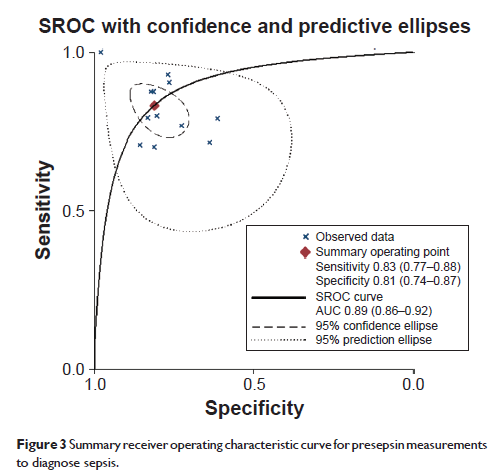9 5 9 0 3
论文已发表
注册即可获取德孚的最新动态
IF 收录期刊
- 3.3 Breast Cancer (Dove Med Press)
- 3.4 Clin Epidemiol
- 2.5 Cancer Manag Res
- 2.9 Infect Drug Resist
- 3.5 Clin Interv Aging
- 4.7 Drug Des Dev Ther
- 2.7 Int J Chronic Obstr
- 6.6 Int J Nanomed
- 2.5 Int J Women's Health
- 2.5 Neuropsych Dis Treat
- 2.7 OncoTargets Ther
- 2.0 Patient Prefer Adher
- 2.3 Ther Clin Risk Manag
- 2.5 J Pain Res
- 2.8 Diabet Metab Synd Ob
- 2.8 Psychol Res Behav Ma
- 3.0 Nat Sci Sleep
- 1.8 Pharmgenomics Pers Med
- 2.7 Risk Manag Healthc Policy
- 4.2 J Inflamm Res
- 2.1 Int J Gen Med
- 4.2 J Hepatocell Carcinoma
- 3.7 J Asthma Allergy
- 1.9 Clin Cosmet Investig Dermatol
- 2.7 J Multidiscip Healthc

已发表论文
Presepsin 作为败血症的诊断标志物: 二元综合分析所产生的证据
Authors Tong X, Cao Y, Yu M, Han C
Published Date July 2015 Volume 2015:11 Pages 1027—1033
DOI http://dx.doi.org/10.2147/TCRM.S84811
Received 17 March 2015, Accepted 4 May 2015, Published 2 July 2015
Approved for publication by Professor Deyun Wang
Background: The diagnosis of sepsis remains a clinical challenge. Many studies suggest that presepsin plays a role in diagnosing sepsis, but the results remain controversial. This study aimed to identify the overall diagnostic accuracy of presepsin for sepsis through meta-analysis.
Methods: A systematic literature search was performed in PubMed and EMBASE to identify studies evaluating the diagnostic accuracy of presepsin in sepsis patients. Data were retrieved and the pooled sensitivity, specificity, positive likelihood ratio, negative likelihood ratio, and diagnostic odds ratio (DOR) were calculated. A summary receiver operating characteristic curve and area under curve (AUC) were used to evaluate the overall diagnostic performance. The statistical analysis was performed using Stata 12.0 and Meta-DiSc 1.4 software.
Results: Eleven publications with 3,106 subjects were included in the meta-analysis. The pooled sensitivity, specificity, positive likelihood ratio, negative likelihood ratio, and DOR were 0.83 (95% confidence interval [CI] 0.77–0.88), 0.81 (95% CI 0.74–0.87), 4.43 (95% CI 3.05–6.43), 0.21 (95% CI 0.14–0.30), and 21.56 (95% CI 10.59–43.88), respectively. The area under the curve was 0.89 (95% CI 0.86–0.92). Estimated positive and negative post-probability values for a sepsis prevalence of 20% were 53% and 5%, respectively. No publication bias was identified.
Conclusion: Based on currently available evidence, presepsin may have a valuable role in the diagnosis of sepsis, and its results should be interpreted carefully in the context of clinical condition and traditional markers.
Keywords: sepsis, presepsin, diagnosis, meta-analysis
Methods: A systematic literature search was performed in PubMed and EMBASE to identify studies evaluating the diagnostic accuracy of presepsin in sepsis patients. Data were retrieved and the pooled sensitivity, specificity, positive likelihood ratio, negative likelihood ratio, and diagnostic odds ratio (DOR) were calculated. A summary receiver operating characteristic curve and area under curve (AUC) were used to evaluate the overall diagnostic performance. The statistical analysis was performed using Stata 12.0 and Meta-DiSc 1.4 software.
Results: Eleven publications with 3,106 subjects were included in the meta-analysis. The pooled sensitivity, specificity, positive likelihood ratio, negative likelihood ratio, and DOR were 0.83 (95% confidence interval [CI] 0.77–0.88), 0.81 (95% CI 0.74–0.87), 4.43 (95% CI 3.05–6.43), 0.21 (95% CI 0.14–0.30), and 21.56 (95% CI 10.59–43.88), respectively. The area under the curve was 0.89 (95% CI 0.86–0.92). Estimated positive and negative post-probability values for a sepsis prevalence of 20% were 53% and 5%, respectively. No publication bias was identified.
Conclusion: Based on currently available evidence, presepsin may have a valuable role in the diagnosis of sepsis, and its results should be interpreted carefully in the context of clinical condition and traditional markers.
Keywords: sepsis, presepsin, diagnosis, meta-analysis
